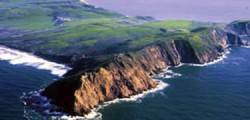
It doesn’t look like much in these photos — frankly it didn’t look like much in reality — but from 1963-1974 and from 1991 until this year this was the tallest manmade structure on earth. It’s the tower of KVLY-TV (originally KTHI-TV) of Fargo, North Dakota, located near Blanchard, North Dakota. It is 2,063 feet tall (629 meters).

From 1974 until it collapsed in 1991, the tallest manmade structure was the Warszawa radio mast in Poland at 2,120.67 feet (646.38 meters). This year (2009) the Burj Dubai in the United Arab Emirates reached 2,684 feet (818 meters).
The KVLY tower is now just the world’s second tallest manmade structure. A few miles away is the third tallest, the slightly shorter KXJB tower, which we could see in the distance. (No other U.S structures are above 2000 feet.)

That’s the Missouri River near Washburn, North Dakota, site of a replica of Lewis and Clark’s 1804-1805 winter camp. What other blog has brought you photos of America’s three longest rivers in the past month?

Lieutenant Colonel George Armstrong Custer and his wife Libby lived in that home at Fort Abraham Lincoln (near present-day Bismarck) from 1873 until 1876. It was from here that Custer led his invasion of the Black Hills in 1874 and began his fated trip to the Little Bighorn Valley in 1876. I have a closer shot of the house, but this is about as close as I like to get to Custer.

Further south along North Dakota highway 1806 is the Standing Rock Reservation. Above is a photo of the tribe’s handsome administrative services building in Fort Yates.
The Standing Rock Sioux Reservation is situated in North and South Dakota. The people of Standing Rock, often called Sioux, are members of the Dakota and Lakota nations. “Dakota” and “Lakota” mean “friends” or “allies.” The people of these nations are often called “Sioux”, a term that dates back to the seventeenth century when the people were living in the Great Lakes area. The Ojibwa called the Lakota and Dakota “Nadouwesou” meaning “adders.” This term, shortened and corrupted by French traders, resulted in retention of the last syllable as “Sioux.” There are various Sioux divisions and each has important cultural, linguistic, territorial and political distinctions.
Standing Rock Sioux Tribe
There is a monument to Sitting Bull (Tatanka Iyotake) in Fort Yates. The monument marks the possible gravesite of the great leader. (There is some dispute whether his remains were removed.)


Great words (click the photo for readable version).
Alas, the usually proud Standing Rock Sioux Tribe has done a poor job maintaining the site that honors its most famous leader.
All photos taken August 29th and 30th, 2009. Click any image for a gallery of larger versions.




















































 Point Reyes National Seashore contains unique elements of biological and historical interest in a spectacularly scenic panorama of thunderous ocean breakers, open grasslands, bushy hillsides and forested ridges. Native land mammals number about 37 species and marine mammals augment this total by another dozen species. The biological diversity stems from a favorable location in the middle of California and the natural occurrence of many distinct habitats. Nearly 20% of the State’s flowering plant species are represented on the peninsula and over 45% of the bird species in North America have been sighted.
Point Reyes National Seashore contains unique elements of biological and historical interest in a spectacularly scenic panorama of thunderous ocean breakers, open grasslands, bushy hillsides and forested ridges. Native land mammals number about 37 species and marine mammals augment this total by another dozen species. The biological diversity stems from a favorable location in the middle of California and the natural occurrence of many distinct habitats. Nearly 20% of the State’s flowering plant species are represented on the peninsula and over 45% of the bird species in North America have been sighted. 






